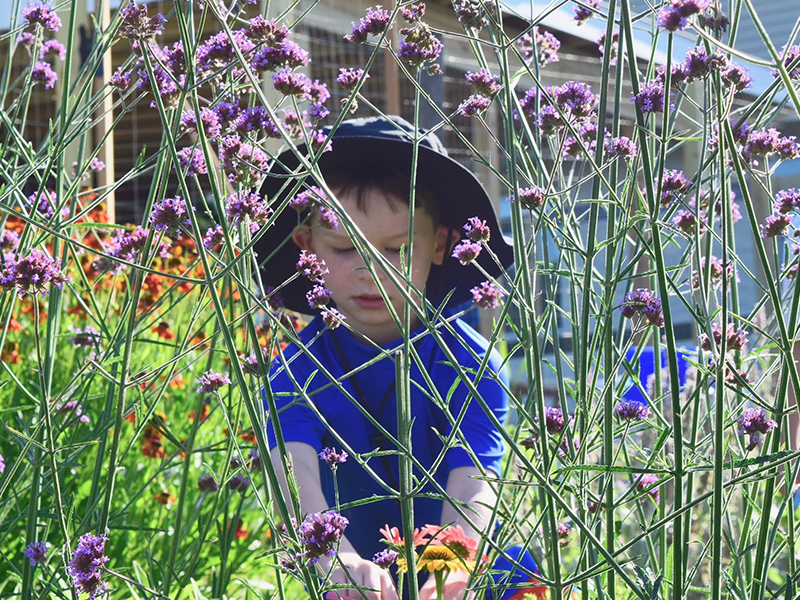When Crossway Community transformed into an outdoor Montessori forest school, a remarkable thing happened. We saw happier, healthier and more engaged children.
After the pandemic hit, our CEO, Kathleen Guinan, sat outside for a couple of weeks to reimagine how we could take our school outside. As a Montessori School, our focus has always been on what’s best for children. The American Academy of Pediatrics urged in-person learning and scientists and pediatricians agreed that we’d be safer outside. To figure out how to make it work, Kathleen drew inspiration from Norwegian forest schools and her connection to Association Montessori International. She hired landscape architects Fritz & Gignoux, who shared her vision, and redesigned our campus, located in Kensington, Maryland, utilizing the same Montessori concepts used indoors. As our team of Montessori guides evolved the curriculum, Fritz & Gignoux reworked the outdoor spaces. Together, we transformed our school into an outdoor Montessori forest school offering a variety of inspiring activity spaces, like gardens, woodland, forest and barns without walls.
The terms “forest school” and “nature-based education” are becoming more well-known (nature preschools and kindergartens have tripled in the United States in the past three years) but they still confuse some people. “What is a forest school”? and “Are you outside the whole day?,” they ask. A forest school is a child-led, nature-based education program, where children learn through exploration and experiences; they learn by doing. Forest and nature-based schools take place mainly outdoors, rain or shine.
At forest schools, children learn the same things as in a traditional curriculum
Like reading, math, art, science and music – but with added benefits, like environmental learning, gardening, life skills, caring for animals, risk-taking and being physically active all day. The key difference is that the environment is the prompt for learning and that children learn through experience. For instance, on our daily walks, children love picking up sticks. They use sticks to measure things and organize them according to length and this way they learn the concept of length. We believe it’s the healthiest way for children to develop physically, emotionally, socially and academically.
Here’s why children thrive at forest and nature-based schools:
- They instill the love of learning; children receive a child-led education in mixed age groups while being free to roam, play, work, eat and even sleep outside in the fresh air.
- They build confidence, critical thinking and independence. Children are encouraged to learn what they’re interested in – so they are curious and more confident to ask questions.
- They help children develop healthy executive functions and self-regulation during the time when their brains develop the most. That’s why early childhood education is so important.
- There’s a growing body of research pointing to the benefits of nature-based learning. A brief by Ming Kuo, Associate Professor, Natural Resources and Environmental Sciences, University of Illinois at Urbana-Champaign, found that experience with nature promotes children’s academic learning and self-awareness. In addition, they have an evolving concept of being environmental stewards.
- It’s well known that being in nature helps reduce stress, improves mental health and reduces symptoms of hyperactivity. Children’s sensory needs are being met in nature and that’s why they are less stressed and symptoms of hyperactivity are reduced.
- They help prevent obesity because children are active all day and exposed to healthy foods from our gardens like kale and bok choy.
- They help prevent the classic health issues children are exposed to at preschools, like runny noses, diarrhea and pinkeye.
- Connecting children to the natural world is important in terms of climate change, so they will grow up to be environmental stewards.
- They promote social and emotional development in children. Mixed age groups are the norm in both Montessori and forest schools, where the older children coach the younger ones, much like a family. Instead of competition there’s cooperation.
Would a forest School be a good fit for your family?
Our families are generally comfortable with being outdoors, for instance, they camp, hike or play sports. They know that children today spend less time outdoors than any other generation and understand the negative implications of nature deprivation. They get that children’s natural interest in learning is fueled even more by learning in and about nature. They are also people who care about the environment and want their kids to care about the environment, too.
We hope to inspire other schools to experiment with outdoor learning. Schools have to be willing to innovate and require public support. This may be a much bigger question of rethinking how we do education in this country.
After all, what’s better than learning and playing outside all day?


